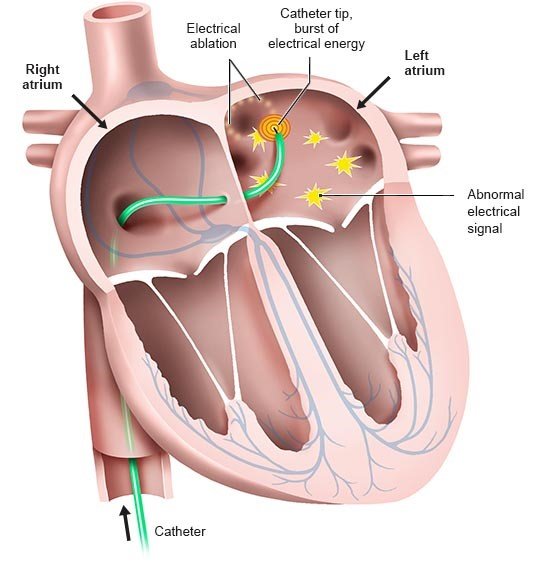Agasthi P, Lee JZ, Amin M et al. Catheter ablation for treatment of atrial fibrillation in patients with heart failure with reduced ejection fraction: A systematic review and meta-analysis. J Arrhythm 2019; 35(2): 171-181.
Asad ZU, Yousif A, Khan MS et al. Catheter Ablation Versus Medical Therapy for Atrial Fibrillation: A Systematic Review and Meta-Analysis of Randomized Controlled Trials. Circ Arrhythm Electrophysiol 2019; 12(9): e007414.
Briceño DF, Markman TM, Lupercio F et al. Catheter ablation versus conventional treatment of atrial fibrillation in patients with heart failure with reduced ejection fraction: a systematic review and meta-analysis of randomized controlled trials. J Interv Card Electrophysiol 2018; 53(1): 19-29.
DeSouza IS, Tadrous M, Sexton T et al. Pharmacologic Cardioversion of Recent-Onset Atrial Fibrillation and Flutter in the Emergency Department: A Systematic Review and Network Meta-analysis. Ann Emerg Med 2020; 76(1): 14-30.
Hindricks G, Eckardt L, Gramlich M et al. Kommentar zu den Leitlinien (2020) der ESC zur Diagnose und Behandlung von Vorhofflimmern. Kardiologe 2021; 15: 354-363.
Hindricks G, Potpara T, Dagres N et al. 2020 ESC Guidelines for the diagnosis and management of atrial fibrillation developed in collaboration with the European Association for Cardio-Thoracic Surgery (EACTS): The Task Force for the diagnosis and management of atrial fibrillation of the European Society of Cardiology (ESC) Developed with the special contribution of the European Heart Rhythm Association (EHRA) of the ESC. Eur Heart J 2021; 42(5): 373-498.
Imberti JF, Ding WY, Kotalczyk A et al. Catheter ablation as first-line treatment for paroxysmal atrial fibrillation: a systematic review and meta-analysis. Heart 2021; 107(20): 1630-1636.
Kasper DL, Fauci AS, Hauser SL et al. Harrison's Principles of Internal Medicine. New York: McGraw-Hill; 2015.
Klein HH, Trappe HJ. Cardioversion in non-valvular atrial fibrillation. Dtsch Arztebl Int 2015; 112(50): 856-862.
Mao YJ, Wang H, Chen JX et al. Meta-analysis of medical management versus catheter ablation for atrial fibrillation. Rev Cardiovasc Med 2020; 21(3): 419-432.
Marrouche NF, Brachmann J, Andresen D et al. Catheter Ablation for Atrial Fibrillation with Heart Failure. N Engl J Med 2018; 378(5): 417-427.
Packer DL, Mark DB, Robb RA et al. Effect of Catheter Ablation vs Antiarrhythmic Drug Therapy on Mortality, Stroke, Bleeding, and Cardiac Arrest Among Patients With Atrial Fibrillation: The CABANA Randomized Clinical Trial. JAMA 2019; 321(13): 1261-1274.
Pschyrembel Online. 2022.
Saglietto A, Gaita F, De Ponti R et al. Catheter Ablation vs. Anti-Arrhythmic Drugs as First-Line Treatment in Symptomatic Paroxysmal Atrial Fibrillation: A Systematic Review and Meta-Analysis of Randomized Clinical Trials. Front Cardiovasc Med 2021; 8: 664647.
Smer A, Salih M, Darrat YH et al. Meta-analysis of randomized controlled trials on atrial fibrillation ablation in patients with heart failure with reduced ejection fraction. Clin Cardiol 2018; 41(11): 1430-1438.
Turagam MK, Garg J, Whang W et al. Catheter Ablation of Atrial Fibrillation in Patients With Heart Failure: A Meta-analysis of Randomized Controlled Trials. Ann Intern Med 2019; 170(1): 41-50.
Turagam MK, Musikantow D, Whang W et al. Assessment of Catheter Ablation or Antiarrhythmic Drugs for First-line Therapy of Atrial Fibrillation: A Meta-analysis of Randomized Clinical Trials. JAMA Cardiol 2021; 6(6): 697-705.
Valembois L, Audureau E, Takeda A et al. Antiarrhythmics for maintaining sinus rhythm after cardioversion of atrial fibrillation. Cochrane Database Syst Rev 2019; (9): CD005049.
Virk SA, Bennett RG, Chow C et al. Catheter Ablation Versus Medical Therapy for Atrial Fibrillation in Patients With Heart Failure: A Meta-Analysis of Randomised Controlled Trials. Heart Lung Circ 2019; 28(5): 707-718.
IQWiG health information is written with the aim of helping people understand the advantages and disadvantages of the main treatment options and health care services.
Because IQWiG is a German institute, some of the information provided here is specific to the German health care system. The suitability of any of the described options in an individual case can be determined by talking to a doctor. informedhealth.org can provide support for talks with doctors and other medical professionals, but cannot replace them. We do not offer individual consultations.
Our information is based on the results of good-quality studies. It is written by a team of health care professionals, scientists and editors, and reviewed by external experts. You can find a detailed description of how our health information is produced and updated in our methods.


